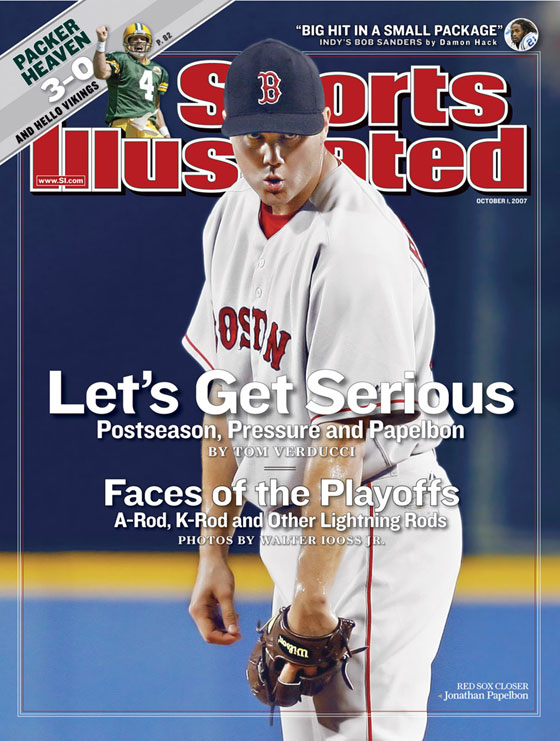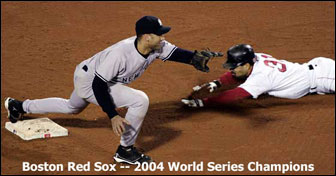Party Time
Party Time
|
|
|
(Sports Illustrated Cover Photo) |
It's Papelbon and Bring It On
Tom Verducci: Late and Great
Tom Verducci, Sports Illustrated, Oct. 1, 2007 Issue:
"You play this game because every day you have the chance to kick somebody's ass and win," Papelbon says. "That's what gets my motor going. And when you put me in that situation 30 to 45 times a year? That seals the deal for me."
There was, however, one problem. Before he could save 36 games in 39 chances (through Sunday), before he could lower his career ERA to 1.65 -- the second lowest of any pitcher after his first three seasons (minimum: 150 innings) -- before he could achieve the best strikeout rate in AL history (13.34 per nine innings) and before he could establish himself as the ultimate weapon for Boston heading into October ("The best closer in baseball," Toronto general manager J.P. Ricciardi calls him), Papelbon and the Red Sox needed to come up with a plan.
They had to come up with a way to keep his shoulder from breaking apart. ...
Each day, when Papelbon reports to work, he sees Reinhold and estimates the fatigue level of his shoulder on a scale of zero to five, with five being the most tired. Then Reinhold hooks him up to a strength-testing machine that supplements Papelbon's subjective score with an objective measurement of his shoulder strength. A report of the scores is logged along with Papelbon's recent usage patterns and presented to Francona and front-office officials. A summary advisement is included, which might give Francona clearance to use Papelbon aggressively or keep him from using the reliever at all.
As more data gets collected, the Red Sox hope to draw some links between Papelbon's usage and his fatigue. Are four-out saves, for instance, more taxing than working consecutive days? The program has worked so well and kept Papelbon so strong that Boston began loosening the rules in September, allowing Francona to use Papelbon three straight days for the first time this year.
Meanwhile, pitching coach John Farrell reworked Papelbon's delivery and practice habits. Farrell tightened up Papelbon's delivery to eliminate any wasted side-to-side movement, which had caused him to follow through toward the first base side of the mound and put additional strain on his shoulder. "More like a Ferris wheel," Papelbon says of his thrust toward home now, "where I'm coming right at you, and less like a carousel."
The result? Six months into the program, the Red Sox say Papelbon has sailed through the regular season in such good health that they can now increase his workload in the postseason, which could mean more eighth-inning appearances and more work on consecutive days -- the Mariano Rivera treatment. Moreover, they are encouraged by the reconfigured postseason schedule, which includes extra off days during the Division and League Championship Series and before the World Series, allowing Papelbon time to rest. Even with a postseason maximum of 19 games, the Sox would still get 13 days off.
The Red Sox might never know what Papelbon could do as a starter, which is fine with him. But they will happily take their 60 innings from him every year. "Thirty years ago you never would have heard of him," Epstein says. "He would have come up, blown out, and that would have been it."
So Papelbon will stick with his program and with his ninth-inning routine, in which he steps off the back of the mound after throwing his warmup pitches, bows his head and says a prayer of thanks.
Thank you, God, for giving me the ability to come out on this particular night. Thank you for letting me come out on this mound in front of 40,000 people and get to do what I love to do and use this ability that you gave me for something good in this world. Amen.
"Once I do that," he says, "it's game time."
And at that very moment, when he climbs back up on the mound, looking for another fight to win, another ass to kick, with neither room to fail nor fear of that outcome, Jonathan Papelbon is exactly where he wants to be."-- Tom Verducci, Sports Illustrated, 9.25.07








